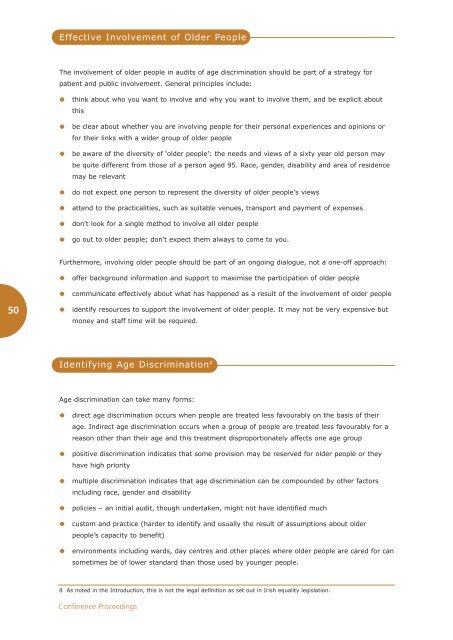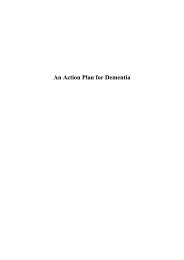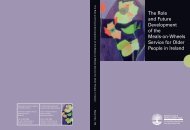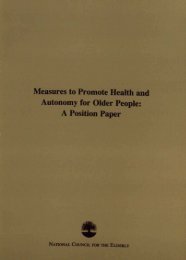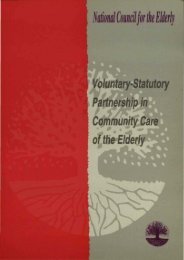From Ageism to Age Equality: Addressing the Challenges ...
From Ageism to Age Equality: Addressing the Challenges ...
From Ageism to Age Equality: Addressing the Challenges ...
Create successful ePaper yourself
Turn your PDF publications into a flip-book with our unique Google optimized e-Paper software.
Effective Involvement of Older PeopleThe involvement of older people in audits of age discrimination should be part of a strategy forpatient and public involvement. General principles include:think about who you want <strong>to</strong> involve and why you want <strong>to</strong> involve <strong>the</strong>m, and be explicit aboutthisbe clear about whe<strong>the</strong>r you are involving people for <strong>the</strong>ir personal experiences and opinions orfor <strong>the</strong>ir links with a wider group of older peoplebe aware of <strong>the</strong> diversity of ‘older people’: <strong>the</strong> needs and views of a sixty year old person maybe quite different from those of a person aged 95. Race, gender, disability and area of residencemay be relevantdo not expect one person <strong>to</strong> represent <strong>the</strong> diversity of older people's viewsattend <strong>to</strong> <strong>the</strong> practicalities, such as suitable venues, transport and payment of expensesdon't look for a single method <strong>to</strong> involve all older peoplego out <strong>to</strong> older people; don't expect <strong>the</strong>m always <strong>to</strong> come <strong>to</strong> you.Fur<strong>the</strong>rmore, involving older people should be part of an ongoing dialogue, not a one-off approach:offer background information and support <strong>to</strong> maximise <strong>the</strong> participation of older peoplecommunicate effectively about what has happened as a result of <strong>the</strong> involvement of older people50identify resources <strong>to</strong> support <strong>the</strong> involvement of older people. It may not be very expensive butmoney and staff time will be required.Identifying <strong>Age</strong> Discrimination 8<strong>Age</strong> discrimination can take many forms:direct age discrimination occurs when people are treated less favourably on <strong>the</strong> basis of <strong>the</strong>irage. Indirect age discrimination occurs when a group of people are treated less favourably for areason o<strong>the</strong>r than <strong>the</strong>ir age and this treatment disproportionately affects one age grouppositive discrimination indicates that some provision may be reserved for older people or <strong>the</strong>yhave high prioritymultiple discrimination indicates that age discrimination can be compounded by o<strong>the</strong>r fac<strong>to</strong>rsincluding race, gender and disabilitypolicies – an initial audit, though undertaken, might not have identified muchcus<strong>to</strong>m and practice (harder <strong>to</strong> identify and usually <strong>the</strong> result of assumptions about olderpeople’s capacity <strong>to</strong> benefit)environments including wards, day centres and o<strong>the</strong>r places where older people are cared for cansometimes be of lower standard than those used by younger people.8 As noted in <strong>the</strong> Introduction, this is not <strong>the</strong> legal definition as set out in Irish equality legislation.Conference Proceedings


